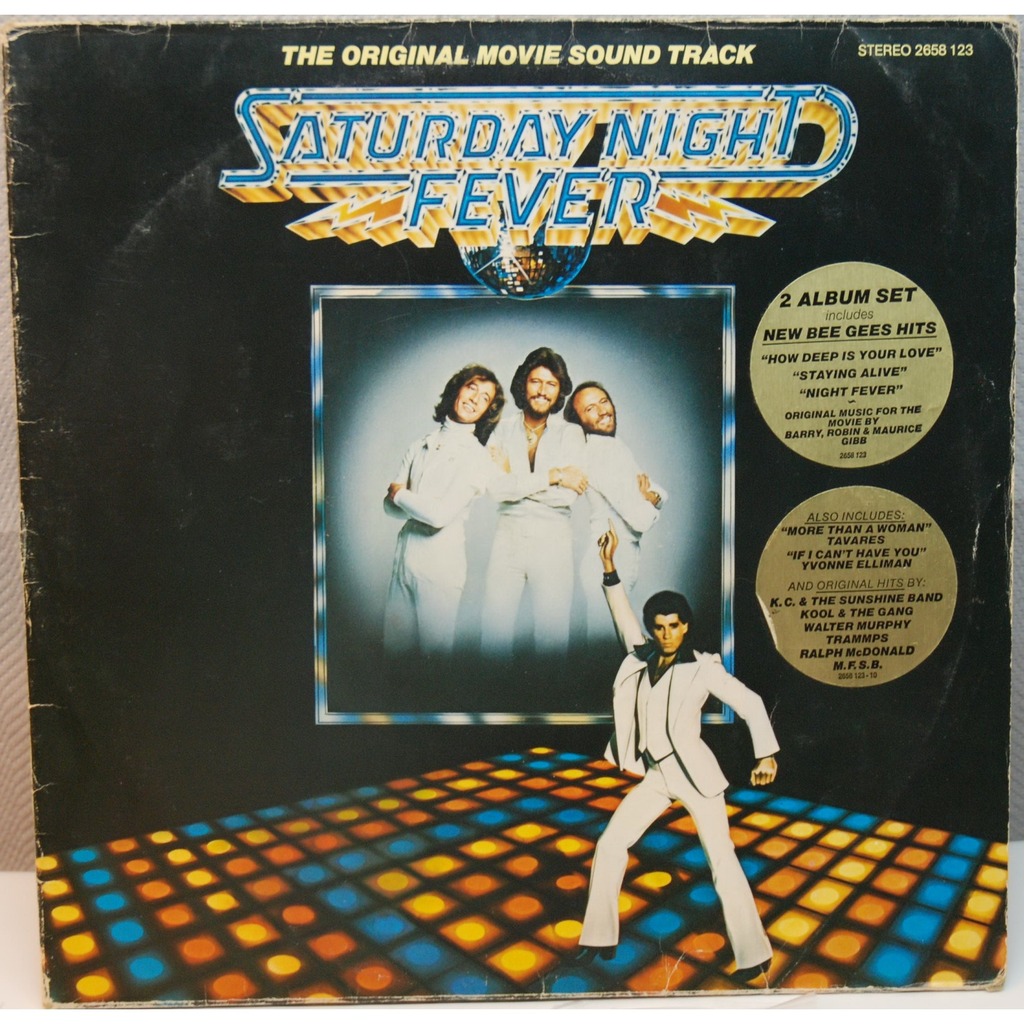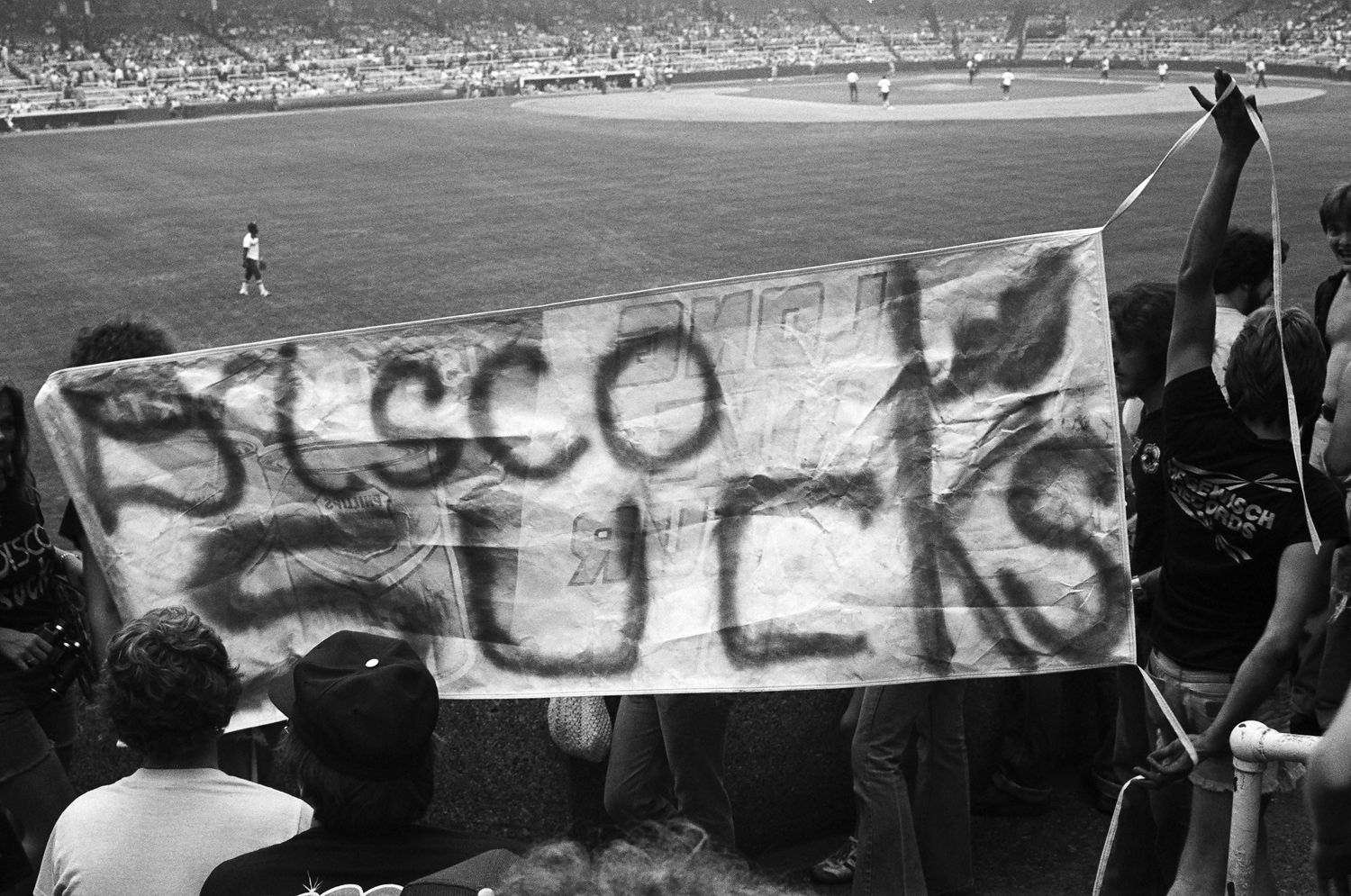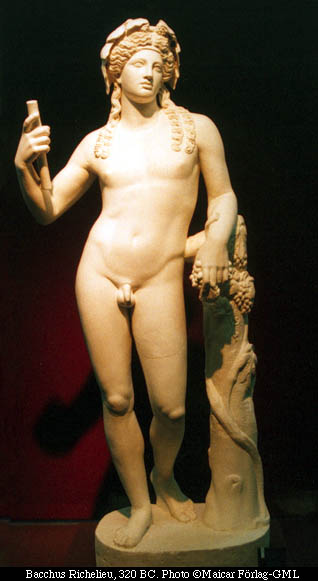
Disco does not suck. At least, as a genre it doesn’t suck, any more than rock n’ roll sucks, or jazz, or hip hop. Certainly, some of it, subjectively speaking, is awful. (I submit: the exquisitely bad “Disco Duck.” But I also submit: Chuck Berry’s “My Ding-A-Ling.”) But to lambast the whole shebang indicates a kind of fear, which we mammals often express as hostility. I see it as fear of gay folks, people of color, sexually confident women, and fear of being ridiculed, i.e. rejected on the dance floor; all fears unfounded, but potent, sad fears nonetheless.
I first saw this fear/hostility of disco as a wee disco fan, when my girlfriend’s cousin Roy took us to the cemetery in Macon, Georgia to show off the cigarette-and-beercan-strewn cultural landmark that is Duane Allman’s grave. Roy also wanted us to see “where the Devil worshippers go,” i.e. a mausoleum with a kicked-in door and walls spray-painted with pentagrams. Like the Allman grave, the “Devil worshipper’s” lair was littered with evidence of unholy partying. Once inside the dank vault, cousin Roy lit a cigarette and mentioned something that was troubling him: my girlfriend’s mom – his aunt – was a weekend disco queen, with a coterie of hilarious, sweet, sharp gay men, and cousin wasn’t happy about that.
“I got no problem with fags, ya’ll” Roy said, lying. “I just hate that fuckin’ disco shit they’s always playing. Disco sucks. And I don’t like the way they look at me.”
This visceral fear of a kind of music, entwined with disgust for a lifestyle, was a new thing for me. (Also the delusion/hope that queer folk were intent on, uh, soiling him.) Disco music, as representative of “fags,” et al, terrified cousin; that pounding, insistent beat, those snaky basslines, overtly pansexual lyrics, stabbing horns and synths, sweeping strings, infectious melodies, and exuberant vocals sung by shameless men and women of varying skin colors and sexual persuasions; all of it connected to moving one’s body among other bodies, known and unknown, in a sweaty, borderless mass, where everyone is both powerful and vulnerable, and no one, but no one, is thinking about getting sick. He did not dig that at all, ya’ll. But I did.
~
My disco love was deep, due in part to the Saturday Night Fever soundtrack. This double album accompanied and influenced my first tastes of physical ardor, and ultimately pointed me in the direction of the people who would shape my life. Is it good? Is it bad? Frankly, I neither know nor care. It was there for me.
When the R-rated Saturday Night Fever landed in theaters around Christmas of 1977, I was a Catholic schoolboy, just shy of thirteen. I was too young to see it by myself, so it radiated a forbidden aura at precisely the time I needed something outré in my life. (I wouldn’t actually see it until 1988 – on VHS.) In a cultural first, adults forbade underage kids from attending the movie, which included gang rape, graphic sex talk, and rampant F-bombs (not a lot of nudity, though), but millions allowed the double LP in their house, where kids like me ate it up.
To this day, I cannot separate the Saturday Night Fever music from the memories of enjoying it while surrounded by beautiful Catholic schoolgirls, all of us, for good and for ill, percolating hormonally. Like Madonna dared to articulate some years later: you want to see sparks? Watch what happens when pubescent kids gaze at brazenly sensual Catholic iconography, all while overseen by celibate teachers preaching abstinence. Mix in the Saturday Night Fever LP and you get combustion. Trust me.
The music itself wasn’t novel to me; as an avid listener to eclectic Top 40 Atlanta radio through much of my childhood, I’d heard a lot of pre-Fever funky R & B and soul before bean counters concocted the “disco” label: The Ohio Players’ “Love Rollercoaster,” the Jimmy Castor Bunch’s “Bertha Butt Boogie,” Kool & the Gang’s “Jungle Boogie,” Isaac Hayes’ “Shaft,” Barry White’s “Love’s Theme,” and Donna Summer’s sonically arresting collaboration with Giorgio Moroder, “I Feel Love.” I adored these pre-Fever tunes as much as my mom’s Beatles LPs or the rock bands I saw on The Midnight Special and Don Kirschner’s Rock Concert, or even the John Denver Greatest Hits Volume II record I won from WQXI. It was all just music to me, satisfying different needs, of which I had a lot.
As disco rose, I did not clock the tribal hedonism of the post-Watergate, post-Vietnam culture, the whys and wherefores of the success of very black and very queer dance music, its move from the wings to center stage. No one told me Saturday Night Fever hetero-ized (well, sort of) and made white a largely gay/Latin/African-American movement. (Not that there’s anything wrong with that.) Until that Macon cousin, I couldn’t conceive the intensity of the “Disco Sucks” rampage greeting disco’s mainstream coming out. The charges of The Rolling Stones, Rod Stewart, and Kiss “selling out” by making disco records didn’t resonate with me.
Even the insane 1979 Disco Demolition Night, the apotheosis of the “Disco Sucks” movement, struck me as just adults acting crazy, which was nothing new in my world. This event, concocted by a publicity-hungry Chicago shock jock, attracted a sellout crowd of fifty-nine thousand people to a White Sox game (with an additional fifteen thousand in the parking lot) where said DJ rode around in a Jeep, hyped up a lily-white crowd, then exploded a crate of disco records, after which thousands of white dudes stormed the field, further damaging it, and forcing the White Sox to forfeit the game to the Detroit Tigers. (Luckily no one was seriously injured, though lots were arrested.) Still, to budding teen me, this expression of “outrage,” and the popular “Disco Sucks” T-shirts, bumper stickers, and buttons didn’t register as homophobic or racist. It seemed just garden variety unkindness.
Once my critical faculties kicked in, however, I recognized the “Death to Disco” campaign as the obnoxious slur it was, and applauded its failure. Sure, the coming decade would see disco, or dance music, cede center stage to Reagan-era arena rock, hair metal, and MTV, but dance music – call it disco, funk, R & B, hip hop, whatever – would never, and will never, die.
~
Let’s moonwalk back to late ’77, when the Saturday Night Fever LP dropped, before its eventual enormo-success freaked out a lot of white heteronormative folks. I was thirteen, so I wasn’t analyzing. All I knew was: this is my jam. Some would argue that when a seventh grader and his Catholic school pals are grooving to disco, it has lost its teeth, the romantic, “cool” days are over, and it’s all about soulless commercialism now. Whatever, Mr. Culture Critic. Carry on. I’ve got dancing to do.
That is the crucial word: dancing. Although music shared among friends was how the phenomenon reached me, the Saturday Night Fever LP wasn’t just music. Encased in a gatefold LP sleeve conferring dark, adult adventure diluted just enough to cross millions of thresholds, Fever also offered nouveau (to us) fashion and an opportunity to explore what our ripening bodies could do via dancing, which I did in a powder blue three-piece suit spritzed with British Sterling cologne.
You didn’t dance to Frampton Comes Alive, or Dark Side of the Moon, or Zeppelin. And like those records, everybody had the Fever double LP, and played all sides constantly. The tunes – all of them, for my money, stellar – dominated the radio and the rec room parties, where clumsy disco hoofing, and first fumbles at intimacy ensued. Saturday Night Fever was the perfect accompaniment to all of that. You had ballads – “How Deep Is Your Love?”– strutting funk – “Stayin’ Alive” – and soul-shouting, hooky dance anthems – “Disco Inferno,” “You Should Be Dancing,” the latter delivered in the Bee Gees’ stratospheric falsettos, woven into distinctive brother harmony.
About those tunes: because the movie, the fashions, the attitudes, the drugs (not on my radar just yet) and the Bee Gees’ vocals, were all ultimately ridiculed by avatars of “taste,” many overlook the high quality of songs, production, and musicianship. But it all holds up. At the time, though, I was becoming a teenager, and all I knew, at least semi-consciously, was what made the girls in the plaid skirts twirl, and it was the Saturday Night Fever songs.
~
Although punk was also fitfully making inroads into pop culture, 1978 became the year of Saturday Night Fever, of Travolta, and a year of awakening for my peers and me. (Incredibly, the PG-rated Grease would drop that summer, a mere six months after Fever.) The Sex Pistols inaugurated their disastrous U.S. tour in Atlanta, of all places, flaming out a couple miles from my neighborhood, at the Great Southeast Music Hall in January of ‘78, but my grandmother and I – both clueless – just watched the coverage on the local news and wrote it off as: “Isn’t that special?”
Saturday Night Fever, by contrast, was a juggernaut, the first one that spoke directly to me. It moved with little help from television. Here in 2015, it’s hard to conceive of those unseen highways of enthusiasm, much less traveled than the overloaded, image-thick paths of today. In 1978, “word of mouth” really was “word of mouth,” delivered by a kid clutching a cardboard record album like a talisman, his/her words thick with soul-deep, motivating truth.
By eighth grade, things were moving fast. I was beginning to appreciate disco’s libidinous overtones, connecting the messages and the feel of the music to my surroundings, to the way my schoolmates moved, talked, conveyed information in the sway of a hip, the curl of a lip, the touch on a shoulder; all, as Madonna pointed out, transpiring in the hothouse of a Catholic school festooned with almost-naked icons everywhere. I was still a “good kid,” but I was consorting with mischief-makers, both boys and girls. I’d lavished attention on some brainy girls, but had forsaken them for more “adventurous” types. An emissary from the brainy girls complained that I was “hanging out in slutsville.”
Around this time, Saturday Night Fever’s true usurping power was revealed. As if in answer to an unholy prayer, something amazing happened: the nuns agreed to let us have an eighth grade disco party. It was like Dionysus himself had won a wrestling match with the God of Abraham, and subdued Him; the god of ritual madness, fertility, and ecstasy would reign, if only briefly.
Surely the school’s staff had seen the cover of the Saturday Night Fever album, featuring the hirsute Bee Gees in skintight, bulging white pants, and surely they knew about the raw, R-rated movie that accompanied the album, in which Tony Manero’s brother leaves the priesthood and a kid begs his girlfriend to abort their out-of-wedlock baby, and surely they knew the music was unapologetically sexual and suggestive. But maybe not. As an adult myself, I will allow than we can be profoundly clueless about such things, sometimes even intentionally so. In any case, the staff of my parochial school agreed all was copacetic: let the kids play their sexy records and boogie in the parish hall below the gym. Without chaperones.
Nothing untoward happened, as far as I know. We self-governed remarkably well. We had a lot of fun, got sweaty and hoarse, danced ‘till about 10 PM, necked in the bushes and the broom closets, all consensual. But the best part was not the very close slow dancing with the girl who’d made me cry in fifth grade, or the kissing and overlong hugging and inept “Frenching” in the shadows. The best part, the clearest memory for me, was Carol.
Carol was a tall, gawky, bespectacled girl with braces and long thick brown hair parted in the middle. She loved, loved, loved John Travolta, to the point of madness. She’d cut out a Travolta “Vinnie Barbarino” beefcake shot from a Tiger Beat magazine and pasted it to her three-ring binder, and she wrote “Vinnie” on all her folders and always sported the same Welcome Back, Kotter T-shirt on our once-monthly non-uniform days. She was the only one among us who’d somehow managed, through expertly wielded teen girl drama, to get her worn-down parents to take her to see Saturday Night Fever before it left the theaters.
No one asked Carol to dance – much less make out – at the disco party. I wish I could say I did, but I did not. She was a wallflower, nursing a Mr. Pibb, watching kids pair up and sneak away to the dark. She projected an air of nonchalance, laughing and talking, adding records to the turntable spindle, but never dancing. Finally, the party was winding down, fluorescent lights winking to life as we re-arranged our grass-stained clothes, fixed our hair, and greeted parents filing in for pick-up.
Someone needed one last hit of disco, and, for the umpteenth time, the needle edged into the vinyl grooves of “Jive Talkin’.” I heard, “Go, Carol!” and there she was, in a long skirt and homely shoes, swinging her hips, her hair flying. Carol was tearing it up. Someone cut the lights and hit the strobe, and Carol went into a kind of trance, moving with unbridled intensity as kids clapped in time and chanted her name: “Ca-ROL, Ca-ROL, Ca-ROL!” The song faded, but she didn’t quit. A new song began, and we let the spell continue.
At last the tone arm of the phonograph left the inner groove, and the music ceased. In a wave of rapturous applause for Carol, the eighth grade disco party was over. Carol, her face shiny with sweat, left with her dad, her shoulders a little less hunched. On Monday, she, like everyone, would walk into school with a morning-after awkwardness, but no apologies. After eighth grade, I would never see her again.
I’d been a party organizer, so I stayed to help clean in the still-crackling air. I swept up popcorn, Cheetos, and a couple of dropped Bonne Bell lip gloss tubes, the smell of Breck shampoo in my nostrils, the muscle memory of a girl’s waist in my fingertips, and the echo of the Bee Gees in my ears. In my marrow, a rhythm pulsed like a big disco bass drum, a beat alongside the pumping of my own heart, complimenting my life force. This rhythm continues to this day. After Catholic school, it led me to the queer, black, defiant mischief-makers, awaiting me in the coming 1980s. That beat propelled me away from bigotry and shame, to acceptance and celebration, to the right side of history.






Wonderful piece. An ancient prophecy by George Clinton warns that the world will not be destroyed by global warming, but by uptight people who can’t dance.
Also, “My Ding-A-Ling” is a classic.
Thanks. I respect and honor your opinion on “My Ding-A-Ling.” And yes, prophet George knew whereof he spoke.
I confess: The disco Stones are my favorite Stones.
The 12″ mix of “Miss You”?
That’s just good music right there.
Also: “Dance Parts 1 &2”
Hey JMB,
Disco Stones did, indeed, rock. Also gave Ronnie Wood a chance to play bass. That’s him on those cuts, making the bootys move. (What was Wyman doing? I shudder to think.) Thanks for the props. See you on the dance floor. RBW
“Certainly, some of it, subjectively speaking, is awful”
I don’t agree, look at that:
http://www.chicagonow.com/when-you-put-it-that-way/2011/09/why-its-time-to-bring-disco-back-really/
A copy-written photo taken by me at Disco Demolition has been used by Weeklings without permission on your web site. I require compensation for this unpermitted, extended usage. Please contact me to discuss terms.